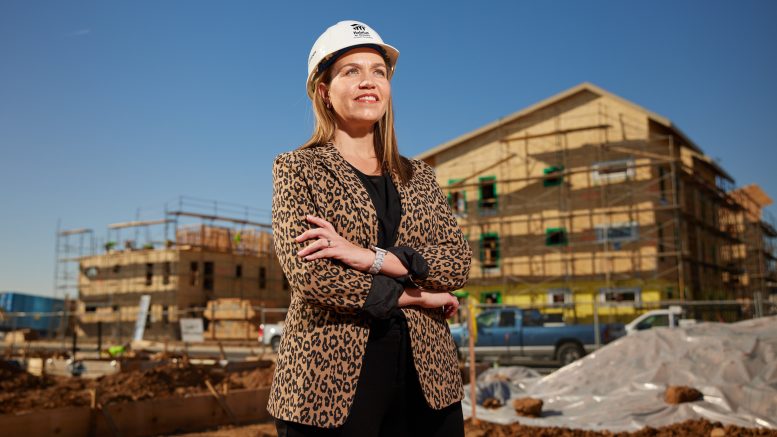By Wendy Weitzel
Leah Miller became president and CEO Habitat for Humanity of Greater Sacramento in 2017. The nonprofit works to eliminate substandard housing by constructing, rehabilitating and preserving homes, advocating for fair policies and providing other resources. It builds more than a dozen houses annually.
We spoke to Miller about how Habitat for Humanity of Greater Sacramento is working to improve the availability of affordable housing in the region.
How does Habitat for Humanity of Greater Sacramento address the need for affordable housing in the region?
For 37 years, Habitat for Humanity has served Sacramento and Yolo counties, creating affordable homeownership opportunities. We especially focus on those previously excluded from those opportunities, often because of systemic racism.
We work to preserve existing affordable housing in the community as well, through our Neighborhood Revitalization and Home Repairs programs, which predominantly serve seniors and veterans, helping them avoid displacement. Also part of our Neighborhood Revitalization program is our Rock the Block initiative, which takes place in the neighborhoods of Oak Park in Sacramento and Bryte/Broderick in West Sacramento. [Rock the Block gathers volunteers and neighborhood residents to conduct home repairs, property beautification and community projects over a single weekend.]
What do you see as the major factors driving the housing crisis in the Sacramento region?
Sacramento regularly ranks as one of the least affordable cities in the county. I think it stems from a significant supply-and-demand imbalance. We need more units.
One of the things driving the housing crisis is that we’re not looking at affordable housing as a spectrum, and making an equitable investment in the production of units throughout it. We need to create housing and wrap-around solutions for the unhoused, as well as bridge housing, affordable rental and affordable homeownership opportunities for the hardworking poor. These folks are often paying more than 50 percent of their income on rent expenses. When paying that much, it’s impossible to save and put down roots that will help build equity — to create the intergenerational wealth that comes from homeownership.
What do you see as the most important and promising solutions to lack of affordable housing?
When we think about solutions, we need to think about how to create more housing units throughout that whole spectrum. There’s no silver bullet to solving the affordable housing crisis in our community. It’s going to take all of us working together and developing out-of-the-box solutions to create the affordable housing solutions that our community truly needs.
We have to think of ways to do things differently. If we keep having the same approach, we’ll continue getting the same result. We have to advocate and partner with local jurisdictions to help streamline and improve the process, [and] eliminate some of the barriers. The more you slow down the process, the more expensive it gets for all parties.
At Habitat, it means trying new things to maximize the funding we have. There’s so little available. Affordable builders and community partners have to figure out new ways to optimize our funding, looking at different models.
For a new community we’re building in South Sacramento — Cornerstone — we’re working with Mutual Housing of California to build an affordable housing community that will soon become home to more than 400 people. This community is a first-of-its kind development in our region, in that it brings together an affordable rental developer and an affordable homeownership developer to create solutions across the spectrum. Together we are leveraging available resources and expertise to build more units.
Why do these solutions offer the most potential to solve the housing affordability problem?
Because when you utilize your expertise and talent, and think out of the box, you’re using your resources to do more and do better, effecting the most change. For example, with Cornerstone, we’re using both brands and resources to do more and do better.
Where do you see evidence that the Habitat for Humanity approach works?
We know that when it comes to Habitat specifically, having an affordable, decent place to live helps mental, physical and financial health, and it creates racial equity. Building financial health has the potential to affect generations to come.
And Habitat homeowners also experience greater educational outcomes. When you have a safe, decent, affordable place to live, you are able to focus on other goals in your life. We see more people pursuing higher education, which benefits all of us.
You really have to want to be a homeowner to partner with Habitat for Humanity. Each of our partner families put in 500 hours of sweat equity before having the opportunity to purchase their Habitat home with a 30-year, 0% interest equivalent mortgage. Three of the five homes recently dedicated [on Nov. 5] were purchased by single moms who work full-time. It isn’t easy to be a parent, work full-time and put in the sweat equity. But each of the families works hard for the opportunity because the security of owning an affordable home provides the opportunity for a better future for their family, especially their kids.
What are the limitations to your efforts in solving the housing affordability problems?
Money. There’s only one source of state funding available, and that’s a fund called CalHome [administered by the California Department of Housing and Community Development]. We’re getting some support from local jurisdictions, but we need to be creative about our approach.
There’s evidence that the need is great in our community. In 2021, we had 7,000 pre-applications for the opportunity to purchase one of just 12 available homes. We’re ramping up. We’ve gone from building eight to 12 homes a year, and now shooting for 20. We have the capacity to do more, yet more funding for production is ultimately needed.
In early November, Habitat handed out keys to five families. All of them had been living in substandard housing with things like mold and caving ceilings. All were paying more than 50 percent of their income on rent. It’s startling to think we have people living in our community who live in those conditions and who are paying so much.
Is there anything else you’d like to add?
We’re building affordable housing that’s also energy-efficient. They are all electric, EV-ready and equipped with solar. We’re making sure — through a partnership with SMUD — that Habitat homes are not just affordable from a mortgage perspective, but from a utility standpoint too.
This Q&A has been edited for length and clarity.
This story is part of the Solving Sacramento journalism collaborative. In 2022, we are focusing on finding solutions to the lack of affordable housing in the Sacramento region. Solving Sacramento is a project of the Local Media Foundation with support from the Solutions Journalism Network. Our partners include California Groundbreakers, Capital Public Radio, Outword, Russian America Media, Sacramento Business Journal, Sacramento News & Review, Sacramento Observer and Univision 19.





Be the first to comment on "Sacramento’s Habitat for Humanity CEO Leah Miller on how we need to look at affordable housing as a spectrum"